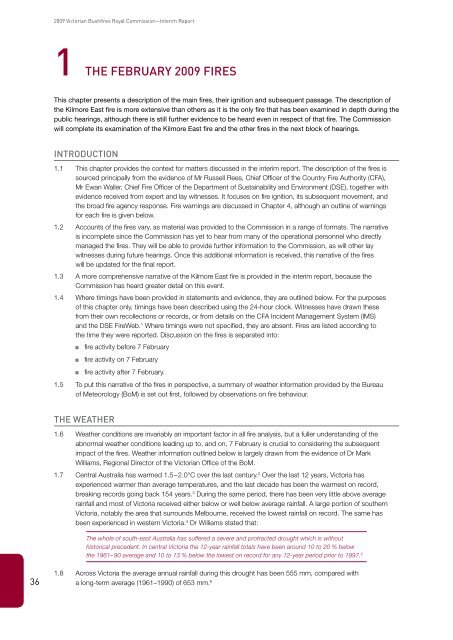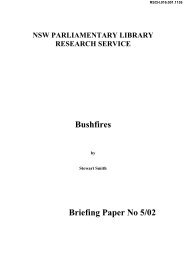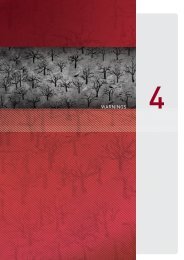the february 2009 fires - 2009 Victorian Bushfires Royal Commission
the february 2009 fires - 2009 Victorian Bushfires Royal Commission
the february 2009 fires - 2009 Victorian Bushfires Royal Commission
Create successful ePaper yourself
Turn your PDF publications into a flip-book with our unique Google optimized e-Paper software.
<strong>2009</strong> <strong>Victorian</strong> Bush<strong>fires</strong> <strong>Royal</strong> <strong>Commission</strong>—Interim Report<br />
1 THE FEBRUARY <strong>2009</strong> FIRES<br />
This chapter presents a description of <strong>the</strong> main <strong>fires</strong>, <strong>the</strong>ir ignition and subsequent passage. The description of<br />
<strong>the</strong> Kilmore East fire is more extensive than o<strong>the</strong>rs as it is <strong>the</strong> only fire that has been examined in depth during <strong>the</strong><br />
public hearings, although <strong>the</strong>re is still fur<strong>the</strong>r evidence to be heard even in respect of that fire. The <strong>Commission</strong><br />
will complete its examination of <strong>the</strong> Kilmore East fire and <strong>the</strong> o<strong>the</strong>r <strong>fires</strong> in <strong>the</strong> next block of hearings.<br />
Introduction<br />
1.1<br />
1.2<br />
1.3<br />
1.4<br />
1.5<br />
This chapter provides <strong>the</strong> context for matters discussed in <strong>the</strong> interim report. The description of <strong>the</strong> <strong>fires</strong> is<br />
sourced principally from <strong>the</strong> evidence of Mr Russell Rees, Chief Officer of <strong>the</strong> Country Fire Authority (CFA),<br />
Mr Ewan Waller, Chief Fire Officer of <strong>the</strong> Department of Sustainability and Environment (DSE), toge<strong>the</strong>r with<br />
evidence received from expert and lay witnesses. It focuses on fire ignition, its subsequent movement, and<br />
<strong>the</strong> broad fire agency response. Fire warnings are discussed in Chapter 4, although an outline of warnings<br />
for each fire is given below.<br />
Accounts of <strong>the</strong> <strong>fires</strong> vary, as material was provided to <strong>the</strong> <strong>Commission</strong> in a range of formats. The narrative<br />
is incomplete since <strong>the</strong> <strong>Commission</strong> has yet to hear from many of <strong>the</strong> operational personnel who directly<br />
managed <strong>the</strong> <strong>fires</strong>. They will be able to provide fur<strong>the</strong>r information to <strong>the</strong> <strong>Commission</strong>, as will o<strong>the</strong>r lay<br />
witnesses during future hearings. Once this additional information is received, this narrative of <strong>the</strong> <strong>fires</strong><br />
will be updated for <strong>the</strong> final report.<br />
A more comprehensive narrative of <strong>the</strong> Kilmore East fire is provided in <strong>the</strong> interim report, because <strong>the</strong><br />
<strong>Commission</strong> has heard greater detail on this event.<br />
Where timings have been provided in statements and evidence, <strong>the</strong>y are outlined below. For <strong>the</strong> purposes<br />
of this chapter only, timings have been described using <strong>the</strong> 24-hour clock. Witnesses have drawn <strong>the</strong>se<br />
from <strong>the</strong>ir own recollections or records, or from details on <strong>the</strong> CFA Incident Management System (IMS)<br />
and <strong>the</strong> DSE FireWeb. 1 Where timings were not specified, <strong>the</strong>y are absent. Fires are listed according to<br />
<strong>the</strong> time <strong>the</strong>y were reported. Discussion on <strong>the</strong> <strong>fires</strong> is separated into:<br />
■■ fire activity before 7 February<br />
■■<br />
■■<br />
fire activity on 7 February<br />
fire activity after 7 February.<br />
To put this narrative of <strong>the</strong> <strong>fires</strong> in perspective, a summary of wea<strong>the</strong>r information provided by <strong>the</strong> Bureau<br />
of Meteorology (BoM) is set out first, followed by observations on fire behaviour.<br />
The Wea<strong>the</strong>r<br />
1.6<br />
Wea<strong>the</strong>r conditions are invariably an important factor in all fire analysis, but a fuller understanding of <strong>the</strong><br />
abnormal wea<strong>the</strong>r conditions leading up to, and on, 7 February is crucial to considering <strong>the</strong> subsequent<br />
impact of <strong>the</strong> <strong>fires</strong>. Wea<strong>the</strong>r information outlined below is largely drawn from <strong>the</strong> evidence of Dr Mark<br />
Williams, Regional Director of <strong>the</strong> <strong>Victorian</strong> Office of <strong>the</strong> BoM.<br />
2<br />
1.7 Central Australia has warmed 1.5–2.0°C over <strong>the</strong> last century. Over <strong>the</strong> last 12 years, Victoria has<br />
experienced warmer than average temperatures, and <strong>the</strong> last decade has been <strong>the</strong> warmest on record,<br />
breaking records going back 154 years. 3 During <strong>the</strong> same period, <strong>the</strong>re has been very little above average<br />
rainfall and most of Victoria received ei<strong>the</strong>r below or well below average rainfall. A large portion of sou<strong>the</strong>rn<br />
Victoria, notably <strong>the</strong> area that surrounds Melbourne, received <strong>the</strong> lowest rainfall on record. The same has<br />
been experienced in western Victoria. 4 Dr Williams stated that:<br />
The whole of south-east Australia has suffered a severe and protracted drought which is without<br />
historical precedent. In central Victoria <strong>the</strong> 12-year rainfall totals have been around 10 to 20 % below<br />
<strong>the</strong> 1961–90 average and 10 to 13 % below <strong>the</strong> lowest on record for any 12-year period prior to 1997. 5<br />
36<br />
1.8<br />
Across Victoria <strong>the</strong> average annual rainfall during this drought has been 555 mm, compared with<br />
a long-term average (1961–1990) of 653 mm. 6
















